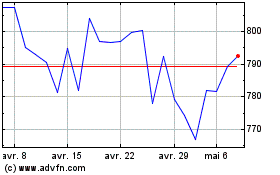By Matthew Dalton
This article is being republished as part of our daily
reproduction of WSJ.com articles that also appeared in the U.S.
print edition of The Wall Street Journal (November 26, 2019).
PARIS -- Tiffany & Co.'s underperforming operations are
about to get an overhaul from one of the world's most exacting
executives, French billionaire Bernard Arnault.
With LVMH Moët Hennessy Louis Vuitton SA's $16.2 billion
purchase of Tiffany, announced Monday, Mr. Arnault plans to pour
marketing resources into the high-end of Tiffany's jewelry line,
focusing attention on its high-carat diamond necklaces rather than
less-expensive silver jewelry. He also wants to launch new product
lines and improve the performance of Tiffany's far-flung network of
321 boutiques in more than 20 countries.
The chief executive is readying a playbook that he has used to
build some of the world's most successful luxury brands at LVMH,
now one of Europe's most valuable companies. His task is to
reinvigorate a storied brand that has been solidly profitable but
whose sales have stagnated in recent years. Comparable sales at
Tiffany have declined for two straight quarters because of a drop
in tourist spending in the U.S.
LVMH is paying all cash for Tiffany's shares and will finance
the deal by issuing bonds. Executives expect it to close in the
middle of next year following antitrust approval by the U.S., the
European Union and others.
Mr. Arnault's strategy calls for labels to benefit from LVMH's
deep pockets, sometimes for years, to make necessary investments.
Mr. Arnault said the purchase of the high-end jeweler Bulgari in
2011 offered a model for the Tiffany buy, requiring major
investments in marketing, boutique design and communications. Eight
years later, the brand's revenue has nearly doubled and its profit
has increased fivefold.
Because those investments take years to bear fruit, Tiffany is
better off inside LVMH, away from the glare of investors
scrutinizing the company's results, Mr. Arnault said. LVMH owns 75
brands, including luxury giants such as Louis Vuitton and Dior, but
doesn't disclose the performance of individual labels.
"We will plan long-term," Mr. Arnault said in an interview.
"Often with American brands traded on the stock market, the
emphasis is placed on the results of the quarter. It's not at all
the same strategic focus."
Mr. Arnault has also pioneered the use of distinctive
architecture in building boutiques, making them destinations for
well-heeled tourists around the world. Customers routinely line up
to get inside Louis Vuitton shops, some of which feature
white-glove service for top clientele.
Last month Mr. Arnault made a visit to Seoul to inaugurate a
Louis Vuitton boutique designed by architect Frank Gehry. Mr.
Arnault quietly took time to pop into a Tiffany boutique
nearby.
As Mr. Arnault browsed the store, he noticed the glass on a
display case was dirty and took a photo of it, telling his team
that it was an example of management failure, a person familiar
with the visit said.
"There are things that are terrific, and there are things that
must be improved," Mr. Arnault said in the interview, when asked
about the episode. "I look at the details."
Tiffany is set to receive such scrutiny on a permanent basis
once the deal is completed. Mr. Arnault regularly visits the
boutiques of his biggest brands in the French capital and on trips
abroad to inspect their operations.
"Each week I make notes, whether it's at Vuitton, Dior or other
brands," Mr. Arnault said.
Tiffany's boutiques are less profitable than those of Cartier
and Bulgari, its major competitors. To address that, LVMH could
tighten its retail network in the U.S., where it has more than 100
stores, says Erwan Rambourg, an analyst at HSBC. Those stores tend
to sell the brand's less expensive jewelry.
Or it could boost efforts to attract Chinese shoppers, who tend
to be more profitable clientele than their Western
counterparts.
"Tiffany is under-indexed with the Chinese," Mr. Rambourg says.
"The Chinese consumer really likes Tiffany but obviously you need
to invest more to develop the awareness."
Despite the problems that struck him in Seoul, Mr. Arnault sees
a huge advantage in Tiffany's retail network: The brand sells
almost exclusively through its own stores, not department stores or
other third parties.
Mr. Arnault frowns on his brands selling wholesale, although
some of the company's smaller ones do. That relinquishes control
over pricing, allowing independent retailers to sell at a discount,
and the look of stores where the brands' wares are displayed.
Louis Vuitton and Dior, for example, sell almost exclusively
through their own stores. Louis Vuitton never holds sales. And both
brands gain intimate knowledge of their clients' spending habits,
data that would be collected by the independent retailer if those
brands didn't rely on directly operated stores.
"Tiffany is in direct contact with its clients. It's one of the
few jewelry brands in that position," Mr. Arnault said. "This is a
fantastic benefit."
Mr. Arnault says that he expects Tiffany to boost LVMH's
operating profit -- EUR10 billion in 2018 -- by around EUR500
million (about $550 million) in the first full year the jeweler is
included in its results. The acquisition will be financed by
issuing bonds at ultralow interest rates now available to LVMH of
less than 1%.
Write to Matthew Dalton at Matthew.Dalton@wsj.com
(END) Dow Jones Newswires
November 26, 2019 02:47 ET (07:47 GMT)
Copyright (c) 2019 Dow Jones & Company, Inc.
Lvmh Moet Hennessy Louis... (EU:MC)
Graphique Historique de l'Action
De Mar 2024 à Avr 2024

Lvmh Moet Hennessy Louis... (EU:MC)
Graphique Historique de l'Action
De Avr 2023 à Avr 2024
